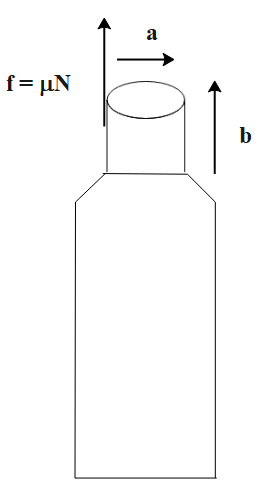Question
Question: A bottle has an opening of radius a and length b. A cork of length b and radius \(\left( {a + \Delta...
A bottle has an opening of radius a and length b. A cork of length b and radius (a+Δa) where (Δa<<a) is compressed to fit into the opening completely (See figure). If the bulk modulus of cork is B and the frictional coefficient between the bottle and cork is μ then the force needed to push the cork into the bottle is:

A. (πμBb)a
B. (2πμBb)Δa
C. (πμBb)Δa
D. (4πμBb)Δa
Solution
In order to find the solution of the given question first we will find the force which is acting on the surface in the opposite direction of the cork, then we will find the value of stress and after substituting all the values in the equation of force we will find the required force needed to push the cork into the bottle.
Formula Used: B=StrainStress
Complete step by step answer:

Force acting on the surface against the direction of the force by cork is given by,
f=μN -(1)
Where ‘f’ is the force, ‘μ’ is the frictional coefficient between the bottle and cork and ‘N’ is the normal force.
Since, we know that,
Stress =AN=(2πa×b)N
⇒B=StrainStress
Here, ‘B’ denotes the bulk modulus of the cork.
⇒Stress=B×Strain
Now, substituting the values we get,
⇒2πabN=B×2πa2×b2πa×Δa×b
⇒N=B×2πa24π2a2b×Δa
⇒N=B×4πb×Δa
So, N=4πΔabB
Substituting the value of ‘N’ in equation (1) we will get,
∴f=μN=(4πbBμ)Δa
Thus, the force needed to push the cork into the bottle is (4πbBμ)Δa.
Hence, option (D) is the correct answer.
Note :
Modulus of elasticity is defined as the measure of the ability of an object or a body to resist deformation. Mathematically, it is given as the ratio of stress and strain. Young’s modulus is a mechanical property of a solid material that measures the stiffness of that material. It is defined as the relationship between stress i.e. force per unit area and strain i.e. proportional deformation in a material in the linear elasticity regime of a uniaxial deformation. Young’s modulus is derived from Hooke’s law for small deformations i.e. when the deformation is small, the stress in the body is proportional to the corresponding strain.
